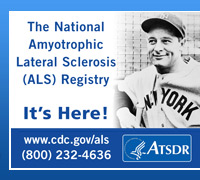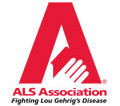



|
National ALS Registry Background & History The ALS Association is the leading organization championing the establishment of a national ALS patient registry that will identify cases of ALS in the United States and collect information that will advance research into the cause, treatment and cure for Lou Gehrig’s Disease. History: >> Congress Enacts the ALS Registry Act, Appropriates $16 Million for ALS Registry >> Creating the Registry: Pilot Project Results, Identifying Cases >> Timeline >> Congressional Funding Needed
Congress Enacts the ALS Registry Act, Thanks to the outreach of people with ALS and ALS Association advocates across the country, The ALS Association partnered with Congress to introduce and enact the ALS Registry Act (Public Law 110-373). Representatives Eliot Engel (D-NY) and Lee Terry (R-NE) and Senators Harry Reid (D-NV) and John Warner (R-VA) were the primary sponsors of the legislation, which garnered broad bipartisan support in both the House of Representatives and the Senate. The House of Representatives passed the legislation by an overwhelming 415-2 vote and the Senate passed it by unanimous consent. President George Bush signed the ALS Registry Act into law on October 8, 2008. The legislation provides the Centers for Disease Control and Prevention (CDC) with the authorization and guidance necessary to create a national ALS registry. At the same time, The Association worked with Congress to secure nearly $16 million in funding for the Registry over the past five years (FY 2006 - FY 2010), including $6 million in FY 2010. Appropriations
Total: $15,644,000 This funding has enabled the CDC/Agency for Toxic Substances and Disease Registry (ATSDR) to conduct pilot projects to determine the most effective and efficient ways to accurately identify ALS cases in the United States and to share information. It also has enabled the Agency to take the first steps towards enrolling patients in the Registry. Importantly, because The ALS Association pursued funding for the Registry even before enactment of the ALS Registry Act, the CDC/ATSDR is able to implement the National ALS Registry much sooner than otherwise would have been possible.
Creating the Registry: Pilot Project Results, Identifying Cases Pilot Projects Over a nearly three year period, the CDC/ATSDR sponsored four pilot projects in order to create the building blocks for the Registry. The pilots were conducted in:
The projects evaluated several different strategies to identify ALS cases, learning how to overcome the significant challenges of effectively and efficiently ascertaining cases of ALS, a disease that progresses rapidly, is not easily diagnosed and often is misdiagnosed or confused with other diseases ranging from Multiple Sclerosis to Parkinson’s disease to Lyme disease. The projects also examined challenges associated with obtaining data, such as privacy and confidentiality laws, regulations and policies, as well as the limitations of administrative databases and medical records, which in addition to potentially including incorrect diagnoses also include administrative errors in the coding of ALS cases. Results from the projects guided creation and implementation of the Registry.
Using data learned from the projects, the CDC has created an algorithm that will enable the Agency to accurately identify approximately 80-85% of ALS cases in the United States by examining large national administrative databases, such as those maintained by Medicare, Medicaid, the Veterans Administration (VA) and the CDC’s National Death Index. The effectiveness of these databases in identifying cases is relatively unique to ALS and is made possible because of changes The Association has championed at Medicare, Social Security and the VA. For example, because the 24-month Medicare waiting period is waived for people with ALS, many more people with the disease are enrolled in the program and therefore can be identified through Medicare records. Similarly, regulations implemented by the VA in 2008 to make ALS a service connected disease also will significantly help to identify an increasing number of cases through VA records. Once an ALS case is identified via this method, it will be included in the National ALS Registry.
In order to identify the remaining 15-20% of cases, the CDC has launched an on-line web portal that allows people with ALS to self-enroll in the Registry via a secure website. The first phase of the portal (www.cdc.gov/als) was unveiled in October 2009 and included general information about ALS and answers to frequently asked questions. Self registration began on October 19, 2010. Prior to the implementation of the self enrollment portion of the web portal, the Agency obtained approval from the Office of Management and Budget (OMB), which is required to comply with privacy and data collection laws. CDC submitted the Registry for OMB approval in January 2010. A notice of the submission is available here: http://edocket.access.gpo.gov/2010/pdf/2010-1718.pdf. The web portal utilizes a combination of strategies, including those learned from the pilot projects, to verify true cases of ALS and to avoid duplication of individuals already enrolled in the Registry. The web portal allows any person with ALS to access the site to enroll in the Registry. The web portal also includes “modules” or questionnaires that collect additional detailed information about ALS cases, including information about:
As with other elements of the Registry, The ALS Association partnered with the CDC in the design of the web portal. In fact, people with ALS tested the web portal prior to its implementation, including during The ALS Association’s 2010 National ALS Advocacy Day and Public Policy Conference. The ALS Association submitted formal comments to the Agency in 2009, which are available here: https://ssl.capwiz.com/alsa/attachments/07_27_09_ALS_Assoc_Comments.pdf. The comments also include recommendations on how the web portal and the Registry can provide people with ALS with additional information about ALS research, including clinical trials, as well as how they may obtain needed care, services and information.
Although the National ALS Registry is expected to identify that vast majority of ALS cases utilizing the online web portal and National databases, the CDC/ATSDR anticipates that gaps may exist in the data collected, particularly in urban and rural underserved areas of the country. Therefore, the Agency is partnering with three states to establish state ALS surveillance projects:
These projects are designed to obtain more detailed information about how to identify additional ALS cases. The CDC is not duplicating state registry projects in all 50 states. Rather, data collected in these states will be used to identify gaps in the National Registry and to develop strategies to improve the operation of the National Registry so that it identifies as many people with ALS as possible throughout the country, including those in underserved areas. Click here to read letters from The ALS Association endorsing the state surveillance projects.
The CDC/ATSDR also is partnering with several large metropolitan areas across the country to further identify gaps that may exist in the National ALS Registry. Like the state based projects, these surveillance projects will identify cases of ALS in large cities and compare cases to those identified in the National ALS Registry. In this way, the metropolitan area projects will enable the CDC/ATSDR to identify where gaps may exist in the National Registry and develop strategies to close those gaps to improve the operation of the National ALS Registry.
October – December 2009
Available on the CDC website at www.cdc.gov/als, the National ALS Registry website includes general information about the ALS Registry, about ALS and answers to frequently asked questions. (As of October 19, 2011, the website includes an online portal that enables people with ALS to self enroll in the registry).
Federal law requires that research projects involving humans receives the approval of Institutional Review Boards (IRBs) to ensure that the rights of patients are protected and that research meets scientific, ethical and regulatory standards. The ALS Registry has received IRB approval.
Under the federal Paperwork Reduction Act, all federal agencies are required to obtain approval from the Office of Management and Budget (OMB) before any data can be collected from United States citizens. OMB approval ensures that data collection is justified and meets other requirements, including privacy requirements. The Centers for Disease Control and Prevention/Agency for Toxic Substances and Disease Registry (CDC/ATSDR) submitted the registry to OMB for review, a process that can take as long as 9-12 months. The notice that the project was submitted to OMB is available here: http://edocket.access.gpo.gov/2010/pdf/2010-1718.pdf. The ALS Registry has received OMB approval.
The CDC/ATSDR is partnering with three states to create state based surveillance projects. The purpose of the projects is solely to obtain additional data that will identify gaps that may exist in the National ALS Registry, particularly cases of ALS occurring in rural and urban underserved areas. The CDC/ATSDR is not duplicating state registry projects in all 50 states. Rather information from the three states will be used to improve the operation of the National ALS Registry. States selected are Florida, New Jersey, and Texas.
The CDC/ATSDR has collected information for the registry from national data sets, including Medicare and Medicaid and the Veterans Administration
The ALS Association is partnering with the CDC/ATSDR to promote the ALS Registry, raise awareness and drive participation in the Registry.
The ALS Association is working with Congress to appropriate $10 million in funding in FY 2011 to continue the Registry and enable this important research project to move forward. Funding in FY 2011 also is needed to begin to realize the promise of the Registry as an engine that will drive research forward, helping to generate vital data that will advance our understanding of the disease, its causes and how it can be diagnosed and treated. On March 19, 2010, Representatives Eliot Engel (D-NY) and Peter King (R-NY) sent a letter to the House Appropriations Committee urging the Committee to appropriate $10 million in funding for the Registry in 2011. The letter was signed by nearly 40 U.S. Representatives. To learn how you can help continue funding for the National ALS Registry, become an ALSA Advocate HERE. The ALS Association will provide additional information about the ALS Registry as it becomes available. If you have any questions, please contact us. |
|
|
 ©2004 - 2010 The ALS Association. All rights reserved.
©2004 - 2010 The ALS Association. All rights reserved.
